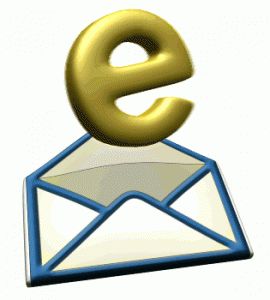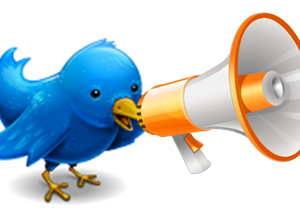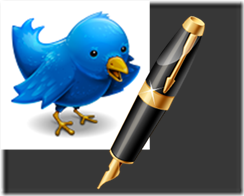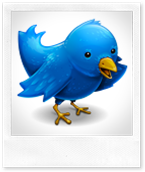Entries Tagged 'twitter' ↓
August 4th, 2010 — copywriting tips, email marketing, freelance copywriter, marketing, twitter
 Email marketing has been a revolution for many businesses.
Email marketing has been a revolution for many businesses.
It has given them an opportunity to market to thousands of people simultaneously and in a very cost effective way. Not only that, but it is also measurable – you can see who’s opened your email, what they did after they read it etc.
But, as a copywriter, one of the hardest aspects of email marketing is coming up with a subject line that makes people want to open the email. It is the do or die. If you can’t get people to open it, you not going to sell them anything.
Creating subject lines takes a lot of work and in my previous post 10 Words That Will Make People Open Your Email I shared with you some powerful words that would help boost your open rate.
But the best way to determine the effectiveness of any subject line it to test it. Split testing is often used – send one group an email with one subject line, and then send another group the same email but with a different subject line. But how about using social media to test their effectiveness?
This, I will admit, was something I’d never actually thought of until I read a post on BlueSkyFactory’s blog. In How to use social media to boost email marketing open rate, Christopher Penn describes how he used Twitter to help determine the effectiveness of an email subject line.
If your Twitter following resembles the demographics of your email marketing list, why not try it out?
If you do, bookmark this post and come back and tell me how you got on.
July 16th, 2010 — copywriter, freelance copywriter, twitter
 It’s been a while since I blogged about Twitter for business, so I’m about to set that straight.
It’s been a while since I blogged about Twitter for business, so I’m about to set that straight.
So are you using it yet?
From conversations I’ve had with people about Twitter, there appear to be many of you that are still undecided about joining the Twitterati. There are others who know they should be part of the feathered gang but aren’t too sure what to do about it.
Twitter isn’t complicated – it is probably one of the easiest tools to use, but you have to learn to use it well.
Tweeting basics
Before you even start to worry about what you should be Tweeting, you have to set your account up.
If you want people to follow you make sure you upload a good avatar – whether it’s a photo of you, your business logo or something else. If you don’t upload one and opt for the generic Twitter image, what is there to set you apart from other people? Don’t be shy, reveal yourself to your followers (boy, that sounds so wrong, but you know what I mean) so they can put a face or company image to the personality.
The next thing you need to do it complete your biography. Not only will this help people find you, it will also make you sound interesting and worth following. Personally, if someone follows me and they don’t have a unique image or a bio, it is very unlikely I’ll follow back. Why should I? I don’t know who they are, what they do or whether I’m going to be interested in anything they tweet.
So before you go any further, make sure you have a good avatar and bio.
As for actually using Twitter to its full potential, take a look at this post by Chris Brogan – 50 Power Twitter Tips – a fantastic resource to get you started and Tweeting successfully. So go and check it out.
I look forward to tweeting with you – you can follow me here.
Sally Ormond – freelance copywriter
May 7th, 2010 — copywriter, social media, twitter

There are millions of Twitter users out there, but how many of them are using it effectively?
How about you? Do you tweet, and if so, how do you tweet?
How do you get from being a solo tweeter, to a tweeter with a constantly growing number of followers?
Twitter = Conversation
That’s it really. Twitter is all about starting a conversation. It’s not about gathering as many followers as possible in the shortest time. It’s not about sending out constant sales messages.
What is it is about, is talking to people and engaging with them.
As a copywriter I use Twitter a lot and have put together a list of the top ten ways you can engage with people and become seen as an interesting person to follow.
1. Tips and facts
Don’t just send out a constant stream of 140 character adverts for your business. If you do, people won’t follow you.
Give out tips and facts that you think others will find useful. If you’re browsing the web and come across an interesting article, tweet about it and include the link.
2. Retweet and acknowledge
If someone you follow says something interesting or tweets a link you like, retweet it and add your own comment.
3. #FF
The Follow Friday hash tag has been around for a while but it’s still very useful. If you like someone #FF them. If people you follow have #FF someone, take a look at their profile and if you like what you read, follow them.
4. Respond
Always take the time to respond to tweets. Engaging and starting a conversation can lead to friendships or even a new client! If you can help with advice, give it – be generous with your knowledge.
5. Talk about a subject
If someone sends out a tweet about a subject you’re interested in, reply to them. Generate a conversation and encourage others to join in.
6. Introduce yourself
When you get a new follower, introduce yourself to them. You can set automatic responders to new followers but there’s no substitute for the human touch.
7. Pick their brains
Twitter is a gold mine of information just waiting to be tapped. If you have a problem ask for their help. You’ll be amazed at the response you get.
8. Say thank you
Such a simple thing to do and very effective. If someone retweets you or answers your plea for help, say thank you.
9. Ask a question
This is the best way to stimulate a conversation. Ask for opinions and respond to those who tweet back. After all, what’s the point in asking a question if you can’t be bothered to continue the conversation?
10. Put people in touch
If you are following someone who you know will be of interest to others, make an introduction. This way you’ll add value to your network and show yourself as a considerate tweeter.
Twitter can be such a powerful tool, everyone should be using it. Many people still ‘don’t get it’ but that could be down to their not using it properly.
Tweet about what you’re doing, feed your blogs into Twitter, talk about interesting facts, link to fascinating information and start a conversation.
Twitter helps you bring a human touch to your business, so use it.
March 29th, 2010 — copywriter, copywriting tips, freelance copywriter, twitter

How can a little social media tool like Twitter possibly improve your writing?
Very easily.
As this great post on Copyblogger by Jennifer Blanchard shows – How Twitter Makes You a Better Writer.
As the Twitter literate out there will know, Twitter messages are limited to 140 characters. And that does mean characters – so every space, punctuation mark and letter or number accounts for one character.
Therefore your writing has to be tighter than, well, a tight thing. There’s no room for adjectives or excessive prose – you have to wrack your brain to find the most succinct way of getting your message across.
Just like when you write sales copy. A copywriter has to keep their writing pithy and to the point. As soon as airy-fairy language creeps in, your reader will walk away.
It takes time to master this, but once you have you’ll discover your Twitter writing will help your copywriting. Your copy will become tighter, punchier and more compelling. You’ll start to take note of every word you use and you’ll be questioning them to ensure you’ve used the most concise and powerful combination to get your message across.
So, put your reserve aside and if you’re not already Tweeting, get started.
If the thought of it still makes you shudder with anxiety, help is at hand. One of the great Twitter Gurus, Mark Shaw (@markshaw), has put together an excellent eBook to help get you started. He’s kindly given me permission to offer it here to anyone who wants it.
So if you want a copy, drop me an email and I’ll send it to you. You can also follow me @sallyormond – why send me your most creative 140 character tweets?
Sally Ormond – freelance copywriter
sally@briarcopywriting.com
March 22nd, 2010 — copywriter, freelance copywriter, SEO copywriter, twitter

Do you use Twitter?
If so, how do you use it?
For a lot of people, Twitter is all about getting as many followers as possible. They don’t care who they are, just so long as their Twitter page shows an astronomically large number of follows.
But for others (me included), Twitter is more about quality rather than quantity. You see, Twitter is a relationship tool. It’s not about who can get the most followers. It’s about who’s out there in the Twitterverse that can add value to your life/business and visa versa.
It can be a fabulous tool for gathering information, finding new partners for business projects, identifying potential new clients. But above all, it allows you to build relationships and trust by giving and sharing great information.
…and the copywriting?
Yeah, OK, I was just getting to that bit.
Let’s take website copywriting as an example. When creating copy for a website, you have to take the reader into consideration. After all you are trying to attract them to the site so you have to write benefits led copy that they’re going to find interesting.
You will utilise SEO skills to ensure you attract targeted traffic to the site.
“Who cares – I just want loads of traffic!”
Sure, everyone wants loads of traffic to their website, but would you rather have 100 visitors a day who don’t hang around or 10 highly targeted visitors who not only visit your site, they also buy.
Just think about that. Every day your site would get 10 buying customers – 70 in a week – 3640 per year.
Of course, to get this type of targeted traffic you’ll have to do your research carefully. Use free keyword tools like Google’s to find your target audience – oh, and start with local key phrases rather than generic ones as the local ones are easier to rank for.
Get your key phrases into your page titles and headings and then write your web copy with them in mind. Don’t worry about density – that’s no longer relevant and you’ll find writing naturally will automatically bring in the right saturation of key terms.
So you see, Twitter is a lot like copywriting. Quantity isn’t that important – it’s the quality that really counts.
 Email marketing has been a revolution for many businesses.
Email marketing has been a revolution for many businesses. It’s been a while since I blogged about Twitter for business, so I’m about to set that straight.
It’s been a while since I blogged about Twitter for business, so I’m about to set that straight.







